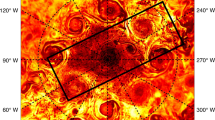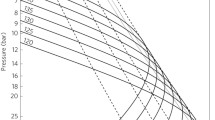Abstract
The energy source driving Jupiter's active meteorology is not understood1. There are two main candidates: a poorly understood internal heat source and sunlight. Here we report observations of an active storm system possessing both lightning and condensation of water. The storm has a vertical extent of at least 50 km and a length of about 4,000 km. Previous observations2,3 of lightning on Jupiter have revealed both its frequency of occurrence and its spatial distribution, but they did not permit analysis of the detailed cloud structure and its dynamics. The present observations reveal the storm (on the day side of the planet) at the same location and within just a few hours of a lightning detection (on the night side). We estimate that the total vertical transport of heat by storms like the one observed here is of the same order as the planet's internal heat source. We therefore conclude that moist convection—similar to large clusters of thunderstorm cells on the Earth—is a dominant factor in converting heat flow into kinetic energy in the jovian atmosphere.


Similar content being viewed by others
References
Ingersoll, A. P. Atmospheric dynamics of the outer planets. Science 248 , 308–315 (1990).
Magalhães, J. A. & Borucki, W. J. Spatial distribution of visible lightning on Jupiter. Nature 349, 311–313 (1991).
Little, B. et al. Galileo images of lightning on Jupiter. Icarus 142, 306–323 (1999).
Ingersoll, A. P., Gierasch, P. J., Banfield, D., Vasavada, A. R. and the Galileo Imaging Team. Moist convection as an energy source for the large-scale motions in Jupiter's atmosphere. Nature 403 630–632 ( 2000).
Ingersoll, A. P., Beebe, R. F., Conrath, B. J. & Hunt, G. E. in Saturn (eds Gehrels, T. & Matthews, M. S.) 195– 238 (Univ. Arizona Press, Tucson, 1984).
Beebe, R. F., Orton, G. S. & West, R. A. in Time-Variable Phenomena in the Jovian System (eds Belton, M. J. S., West, R. A. & Rahe, J.) 245– 288 (NASA SP-494, Washington, 1989).
Smith, B. A. et al. The Jupiter system through the eyes of Voyager 1. Science 204, 951–972 ( 1979).
Banfield, D. et al. Jupiter's cloud structure from Galileo imaging data. Icarus 135, 230–250 ( 1998).
West, R. A., Strobel, D. F. & Tomasko, M. G. Clouds, aerosols, and photochemistry in the jovian atmosphere. Icarus 65, 161– 217 (1986).
Lewis, J. S. The clouds of Jupiter and the NH3-H2O and NH3-H 2S systems. Icarus 10, 365– 378 (1969).
Limaye, S. S. Jupiter: New estimates of the mean zonal flow at the cloud level. Icarus 65, 335–352 ( 1986).
Vasavada, A. R. et al. Galileo imaging of Jupiter's atmosphere: The Great Red Spot, equatorial region, and white ovals. Icarus 135, 265–275 (1998).
Maddox, R. A. Mesoscale convective complexes. Bull. Am. Meteorol. Soc. 61, 1374–1387 (1980).
Emanuel, K. A. Atmospheric Convection (Oxford Univ. Press, New York, 1994).
Houze, R. A. Cloud Dynamics (Academic Press, San Diego, 1993).
Acknowledgements
This work has been supported by the NASA Planetary Atmospheres Program and the NASA Galileo Project. A. Hock and O. Othman assisted with map projections and image pointing corrections.
Author information
Authors and Affiliations
Corresponding author
Rights and permissions
About this article
Cite this article
Gierasch, P., Ingersoll, A., Banfield, D. et al. Observation of moist convection in Jupiter's atmosphere. Nature 403, 628–630 (2000). https://doi.org/10.1038/35001017
Received:
Accepted:
Issue Date:
DOI: https://doi.org/10.1038/35001017
- Springer Nature Limited





